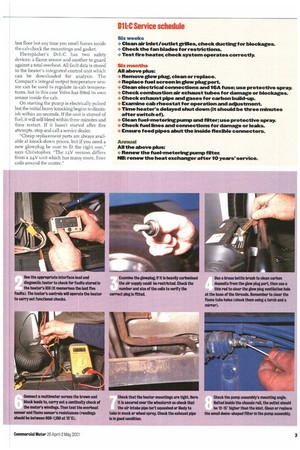T ime was when auxiliary cab heaters were unheard of; drivers
Page 40

Page 41

If you've noticed an error in this article please click here to report it so we can fix it.
usually slept in nearby lodgings and in the morning the cab took ages to thaw out. Nowadays most long-haul vehicles have comfortable high-roof sleeperibs with diesel-burning heaters as well as the ngine's heating and ventilation system.
Sophisticated timers-cum-alarms and adin switches ensure that the driver wakes p in a cosy environment. In certain counies, where temperatures remain well below ero for long periods, these heaters are cornulsoty; even here they're seen as more a ecessity than a luxury.
But like all mechanical devices, if cab heaters are to perform when they're most needed they have to be maintained regularly.
Eberspacher's popular DrI..-C Compact heater, for example, requires a monthly ftinction and ducting check with a more thorough service every six months.
To find out what this entails we visited Auto Electrical Services in Leighton Buzzard, one of Eberspkher's 58 service agents, where the manufacturer's own service manager, Paul Christopher, was running the rule over a Compact fitted in a very tidy Volvo EHrz 420 CD 4x2 tractive unit
The Volvo belongs to nearby 584 Pierce Transport; driver Jim Swarbrick works regularly across Europe for up to two weeks at a time so despite the high-spec Globetrotter
cab, the diesel-burning Eberspacher is well worth the extra L65o or so. Pierce has it set into the cab's nearside toolbox, protected by a bolt-in partition. Nothing combustible must be stored in there. On full heat, Christopher reckons a well serviced Compact will use no more than 0.2 of a litre an hour (1,8kW/22W) or less than half that on low (o.85kW/8W).
The Compact draws fresh air from inside the cab, heats it and then blows it back into the interior (the heating process occurs in a separate combustion chamber).
Diesel is drawn from the tank along a 2.omm pipe, through a metering pump and then pushed through a I.5mm pipe round the chassis and into the heater.
Fed by a separate air supply and fan, the fuel/air mix is blown through a gauze screen and round a zoV glowplug. Ignition occurs within the burning chamber inside the heat exchanger where the heat transfers to fresh air blown through the fins to warm the cab.
In this case the heater is sealed to the tool box floor but any time you smell fumes inside the cab check the mountings and gasket.
Eberspacher's Di L.-C has two safety devices: a flame sensor and another to guard against a total overheat. All fault data is stored in the heater's integrated control unit which can be downloaded for analysis. The Compact's integral output temperature sensor can be used to regulate in-cab temperatures, but in this case Volvo has fitted its own sensor inside the cab.
On starting the pump is electrically pulsed but the initial heavy knocking begins to diminish within zo seconds. If the unit is starved of fuel, it will self-bleed within three minutes and then restart. If it hasn't started after five attempts, stop and call a service dealer.
"Cheap replacement parts are always available at knock-down prices, but if you need a new glowplug be sure to fit the right one," says Christopher. The 12,V version differs from a 24V unit which has many more, finer coils around the centre."
































































































